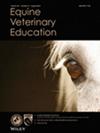新生儿纯种母马单侧输尿管缺损的诊断与保守治疗
IF 0.8
4区 农林科学
Q3 VETERINARY SCIENCES
引用次数: 0
摘要
一匹8日龄的纯种母马被诊断为疑似尿腹膜。体格检查、经腹超声检查、生化检查及腹腔穿刺检查均符合尿腹膜的诊断。剖腹探查发现尿管破裂,但术后28小时尿腹膜复发。计算机断层排泄尿路造影证实疑似输尿管破裂。母马通过腹部引流管进行保守的排尿。2天后夹住腹腔引流管,无尿腹膜复发,母马于11天后出院。本文章由计算机程序翻译,如有差异,请以英文原文为准。

Diagnosis and conservative management of a unilateral ureteral defect in a neonatal Thoroughbred filly
An 8-day-old Thoroughbred filly presented for suspected uroperitoneum. Physical examination, transabdominal ultrasound, biochemistry profile and abdominocentesis were consistent with a diagnosis of uroperitoneum. Exploratory laparotomy revealed a ruptured urachus, but the uroperitoneum recurred at 28 h post-operatively. Computed tomography excretory urography was performed and confirmed the suspected diagnosis of a ruptured ureter. The filly was managed conservatively with urine removal via an abdominal drain. The abdominal drain was clamped after 2 days with no recurrence of uroperitoneum, and the filly was discharged 11 days after presentation.
求助全文
通过发布文献求助,成功后即可免费获取论文全文。
去求助
来源期刊

Equine Veterinary Education
农林科学-兽医学
CiteScore
2.40
自引率
22.20%
发文量
132
审稿时长
18-36 weeks
期刊介绍:
Equine Veterinary Education (EVE) is the official journal of post-graduate education of both the British Equine Veterinary Association (BEVA) and the American Association of Equine Practitioners (AAEP).
Equine Veterinary Education is a monthly, peer-reviewed, subscription-based journal, integrating clinical research papers, review articles and case reports from international sources, covering all aspects of medicine and surgery relating to equids. These papers facilitate the dissemination and implementation of new ideas and techniques relating to clinical veterinary practice, with the ultimate aim of promoting best practice. New developments are placed in perspective, encompassing new concepts and peer commentary. The target audience is veterinarians primarily engaged in the practise of equine medicine and surgery. The educational value of a submitted article is one of the most important criteria that are assessed when deciding whether to accept it for publication. Articles do not necessarily need to contain original or novel information but we welcome submission of this material. The educational value of an article may relate to articles published with it (e.g. a Case Report may not have direct educational value but an associated Clinical Commentary or Review Article published alongside it will enhance the educational value).
 求助内容:
求助内容: 应助结果提醒方式:
应助结果提醒方式:


